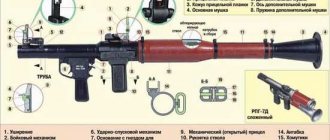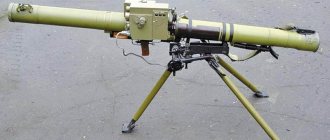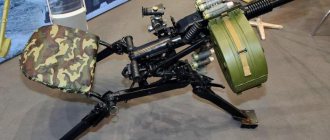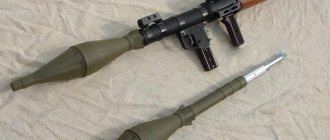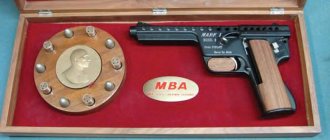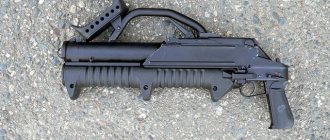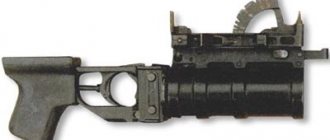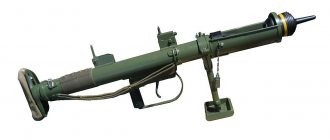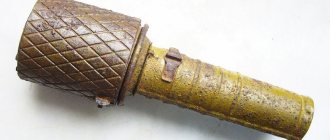Modifications
Work on modernizing the system practically did not stop, which gave rise to several modifications.
It also made it possible to create a weapon so successful that it is still used by the army to this day. Taking into account the experience gained when creating an infantry grenade launcher, the designers later developed a smoothbore gun for the first infantry fighting vehicles and infantry fighting vehicles. "Spear" represents the 2nd generation of domestic grenade launcher systems.
SPG-9D
This version has been modified to meet the needs of paratroopers. The main difference is the wheels on the frame.
SPG-9D
SPG-9M
An updated version in which the sighting device was replaced. The sight consisted of two articulated segments: the first allowed direct fire, the second allowed the use of weighted fragmentation ammunition. The machine was equipped with a telescopic “leg” at the front.
SPG-9M
PGN-9
A sighting device for combat at night. Passive infrared sight, designed specifically for use on the SPG-9.
In addition to these modifications, models with the abbreviation are known:
- DN;
- MN.
Both options differ from the basic ones (D, M) by the presence of a sight for night combat.
Night sight for SPG-9
Operators
Countries that use RPG-7
|
|
|
|
|
The RPG-7 is also used by illegal armed groups and organized crime in almost all countries of the world.
Characteristics of RPG-28 "Cranberry"
Below are the tactical and technical characteristics of the RPG-28 hand grenade launcher.
| Caliber, mm | 125 |
| Length, mm | 1200 |
| Weight, kg | 12 |
| Sighting range, m | 300 |
| Armor penetration, mm: | |
| steel behind dynamic protection | 900 |
| brickwork | 3000 |
| Reinforced concrete | 2400 |
Video: shot from RPG-28
https://youtube.com/watch?v=GOvK4hj1CHI
The following can be noted: the RPG-28 “Klyukva” is one of the most advanced grenade launchers in service with the Russian army. It is ideal for modern combat and can work effectively against the latest enemy tanks. In terms of its characteristics, it is in no way inferior to its foreign analogues, and even surpasses them. This grenade launcher system was “taught” primarily to effectively fight against new types of armor made of composite materials, as well as built-in and mounted dynamic protection. This grenade launcher can successfully hit all types of tanks that are currently in service with the leading world powers.
Ammunition for RPG-7
Shot device for RPG-7
Despite the variety of existing shots for the RPG-7, they all have a similar structure and differ only in the type and structure of the warhead.
The shot is divided into three parts: the head part, which ensures direct destruction of the target, the jet engine, which ensures the acceleration of the grenade along the flight path, and the powder charge, which ensures that the grenade is ejected from the grenade launcher tube.
Diagram of the structure of a PG-7V shot for the RPG-7 grenade launcher
| I - Head part, 1 - head part of the fuse, 2 - conductive cone, 3 - fairing, 4 - cumulative funnel, 5 - body, 6 - bursting charge, 7 - conductor, 8 - bottom part of the fuse, | II - jet engine, 9 - nozzle block, 10 - nozzle, 11 - jet engine body, 12 - jet engine powder charge, 13 - rocket engine bottom, 14 - igniter capsule, | III - powder charge, 15 - feather stabilizer, 16 - paper sleeve, 17 - powder charge, 18 - impeller, 19 - tracer, 20 - foam wad. |
Nomenclature of grenades for RPG-7
The grenade launcher itself has changed little, but grenades of various types have been developed for it: cumulative anti-tank, including tandem, high-explosive anti-personnel, thermobaric (volumetric detonating), incendiary, as well as training and other types of grenades.
| Year | Shot index / GRAU index) | Image | Warhead type | Shot weight, kg | Head caliber, mm | Armor penetration, mm | Initial speed of the grenade, m/s | Sighting range, m |
| PG-7V/7P1 | cumulative | 2,2 | 85 | 260 | 120 | 500 | ||
| PG-7VM/7P6 | cumulative | 2 | 70 | 300 | 120 | 500 | ||
| PG-7VS / 7P13 | cumulative | 2 | 72 | 400 | 120 | 500 | ||
| PG-7VL "Luch" / 7P16 | cumulative | 2,6 | 93 | 500 | 120 | 300 | ||
| PG-7VR “Resume” / 7P28 | tandem cumulative | 4,5 | 64 / 105 | DZ + 650 | 100 | 200 | ||
| TBG-7V "Tanin" / 7P33 | thermobaric | 4,5 | 105 | n/radius of destruction of manpower: 10 m | 100 | 200 | ||
| OG-7V "Oskolok" / 7P50 | fragmentation | 2 | 40 | n/a Explosive mass 0.4 kg, 1000 fragments. The affected area is 150 m². | 120 | 700 |
The principle of firing a grenade launcher
To load the projectile, the nozzle is tilted to the left, and the charge is added manually. When the shutter is closed, the contacts of the electrical circuit built into the unit are closed. The gunner cocks the trigger using the handle provided for this purpose. He is also waiting for a command to press the trigger that drives the generator. It delivers an electrically triggered discharge in the breech. The grenade igniter ignites the starting charge and the ammunition is pushed out of the barrel. The diaphragm remains in the barrel.
Memo on the ammunition
The grenade begins to rotate as it moves along the barrel due to the holes in the tail. This increases accuracy, since rotation stabilizes the projectile.
As the ammunition accelerates down the barrel, the pressure of the powder gases increases. When the limit values are reached, the disk located in the tail section remaining in the barrel is destroyed. Due to this, excess pressure is released through the nozzle, recoil is minimized.
After leaving the barrel, the blades on the tail of the grenade open. This happens due to centrifugal force and pressure of the oncoming air flow. The main engine starts 15-20 meters from the grenade launcher.
The crew may not have to wait for the flight to complete, as is required for guided missiles. You can immediately open the bolt after firing and load a new grenade. The part remaining from the previous projectile is ejected automatically when the bolt is opened.
History of the creation of the RPG-18
The first single-use anti-tank rocket launcher in the USSR was created by a design group, the main leading designers of which were I.E. Rogozin. and Baraboshkin V.I.
In the course of detailed and lengthy development, the RPG-18 was invented. In the course of testing its characteristics and performance, the name “Mukha” became attached to the grenade launcher, which was associated with the unique design of the front sight.
In 1971, the hand grenade launcher successfully passed field tests, and already in 1972 it was put into service with the Soviet Army. Thus, the RPG-18 hand-held anti-tank grenade launcher replaced the RKG-3, an anti-tank cumulative grenade.
The idea of creating a “disposable” grenade launcher was not new. However, a distinctive feature of the new product from the Swiss Miniman grenade launcher, which was in service with many armies at that time, was that the grenade had a jet engine.
However, the RPG-18 was created according to a scheme proven at that time, which consisted of a launch container (it was also used for storage and transportation) and a striking element. The container was equipped with:
- trigger mechanism,
- sight.
It represented a double telescopic tube - there was an aluminum tube inside the fiberglass tube.
Grenade Launcher Evaluation
RPG-7V2
By the end of the 1980s, the RPG-7 was in service in more than 40 countries around the world.
Flaws
- The jet stream of the starting charge, coming out from the rear, is capable of causing serious damage at a distance of up to 30 meters (this disadvantage applies to the entire class of recoilless weapons, except for grenade launchers designed for firing from enclosed spaces).
- Comparison of popular grenade launcher models
| Weapon | Diameter | starting speed | Warhead | Armor penetration (estimated) | Range | Optical sight with magnification |
| M67 | 90 mm | 213 m/sec. | 3.06 kg (HEAT ammunition) | 350 mm | 400 m | 3X |
| M2 Carl Gustaf | 84 mm | 310 m/sec. | 1.70 kg (HEAT ammunition) | 400 mm | 450 m | 2X |
| LRAC F1 | 89 mm | 300 m/sec. | 2.20 kg (HEAT ammunition) | 400 mm | 600 m | No source |
| RPG-7 | 93 mm | 120 m/sec. | 2.6 kg (HEAT ammunition) | 500 mm | 500 m | 2.7X |
| B-300 | 82 mm | 280 m/sec. | 3.00 kg (HEAT ammunition) | 400 mm | 400 m | No source |
Description of design
The GP-25 is a single-shot rifled grenade launcher, loaded from the muzzle. The weapon consists of three parts: the breech, the barrel with mount and sight, and the trigger mechanism. To carry a grenade launcher, it is usually disassembled into two parts: a barrel with a sight and mount, and a breech with a trigger mechanism. The grenade launcher kit also includes a special rubber butt pad for the butt and tools for cleaning and maintaining the weapon.
The length of the GP-25 barrel is five grenade launcher calibers (205 mm), it has 12 right-hand rifling, and a special spring-loaded retainer holds the grenade in the barrel bore.
The trigger mechanism of the GP-25 is hammer type, self-cocking. The grenade launcher's trigger moves in a straight line; with the help of a hook, it pulls the trigger back and compresses the mainspring. Then the trigger breaks off the hook and sends the firing pin forward, which breaks the grenade primer. The GP-25 has a safety lever with two positions, as well as a special mechanism that blocks the striking mechanism if the grenade launcher is not installed correctly on the machine gun. The latch in the barrel is also connected to the firing mechanism, and if the grenade is not fully loaded, then it is impossible to fire a shot - the firing pin is blocked.
For the convenience of the shooter, the GP-25 is equipped with a plastic hollow handle.
The grenade launcher's sights allow direct and semi-direct fire. The maximum range for both mounted and surface shooting is 400 meters.
The grenade launcher can be unloaded using a special extractor.
The standard shot for the GP-25 is the VOG-25, which is manufactured using a caseless design. This means that both the primer and the propellant charge are located inside its body (in the bottom part). This design made it possible to significantly simplify the design of the ammunition, as well as increase the rate of fire of the weapon several times.
The grenade has a steel body, under which there is a cardboard mesh, which facilitates the rational formation of fragments during detonation.
The grenade is equipped with a contact-action head fuse with long-range cocking and a self-destructor. The ammunition is cocked at a distance of 10-40 meters from the muzzle. The self-destructor operates 12-14 seconds after the shot.
In addition to the VOG-25 ammunition, the GP-25 can use VOG-25P jumping grenades and the Gvozd grenade with tear gas. VOG-25P has a special charge that is triggered after a grenade collides with an obstacle and throws it 0.5-1 meter. And only then the fuse goes off.
The VOG-25 has an effective destruction radius of five meters.
Video RPG-22
https://youtube.com/watch?v=NM_Y7GRegYY
The creation of a new model was determined by the insufficient armor penetration of the RPG-18 grenade launcher for that time, as well as the need to create a disposable grenade launcher with a single-tube design. The grenade launcher's launcher is a thin-walled pipe, to which the nozzle is connected telescopically. The attachment is designed to lengthen the muzzle of the pipe in the combat position. When spreading, the pipe and nozzles make up the barrel of the launcher. The PU pipe is made of fiberglass (the same material is used in the RPG-18 grenade launcher), and the nozzle is made of polyamide PA6-211-DS.
The RPG-22 launcher is closed with lids until it is transferred to the firing position. To transfer the hand-held anti-tank RPG-22 to the combat position from the traveling position, it is necessary: - pull out the pin, push the attachment forward all the way, while the front cover is folded down, the front sight, freed from the casing, folds up under the action of a spring, taking a vertical position; - move the rod all the way back, while under the influence of the spring as well as elastic forces, the rear hinge cover is turned off from the launcher; - turn the safety post up all the way, and the trigger is cocked. The front sight has sighting marks marked “5”, “15”, “25” . They correspond to firing ranges of 50 m, 150 m and 250 m. On the “15” mark, which corresponds to a range of 150 m, there are rangefinder protrusions. The distance between the protrusions corresponds to the projection of the width of the tank, which is located at the corresponding distance.
RPG-22 shot
For firing in conditions of limited visibility (at ranges up to 100 m), there is a protrusion on the front sight, and the safety post has a slot. In addition, on the safety stand, which is used to mount the diopter, there are “+” and “-” signs, which are intended for introducing temperature corrections for ambient temperatures of 0°C ... +50°C and -50°C ... 0°C, respectively, at shot. Unlike the RPG-18 grenade launcher, the engine’s reactive charge is a “brush type” charge of 7/1 TR V/A gunpowder. The charge is a bundle of tubular powder, which is pinched at the front end. This charge design increases unit impulse while reducing engine operating time. The head of the grenade is filled with an explosive of the Okfol brand.
The shot is fired after pressing the trigger lever (the rear shoulder of the sear). The RPG-22 cannot be transferred to the stowed position from the combat position. If the grenade is not used, it will be discharged with a shot. In 1981, the RPG-22 “Netto” rocket-propelled anti-tank grenade, based on the results of field and military tests, was adopted by the SA, but by this time (more precisely in 1980) the TTZ was approved ( tactical and technical assignment) for the development of an anti-tank rocket-propelled grenade of increased efficiency with the RPG-26 “Aglen” (disposable grenade launcher).
RPG-22 rocket-propelled anti-tank grenade, launcher in firing position, grenade in position after firing
Firing delays and ways to eliminate them
A grenade launcher, with proper care and conservation, and careful handling, is a reliable and trouble-free weapon. However, as a result of careless handling of the grenade launcher, contamination and wear of parts, as well as a malfunction of the grenade, there may be delays in firing
If there is a delay when firing, re-cock the hammer and continue shooting. If the delay repeats, reload the grenade launcher and continue firing. If recharging does not eliminate the delay, find out and eliminate the cause of the delay as indicated below.
| Delay | Reasons for delay | Remedies |
| 1. Misfire (no shot) | 1. The shot into the grenade launcher barrel was not fully fired. 2. Malfunction of the grenade igniter primer. 3. Wear or breakage of the striker. 4. Low impact of the firing pin on the igniter primer due to contamination or hardening of the lubricant of the trigger and firing pin mechanisms | Send the shot until the lock stops at the bottom of the cutout on the muzzle of the grenade launcher barrel. Replace the grenade. Change. Clean the trigger and firing mechanism. |
| 2. The shot does not enter the grenade launcher barrel | The barrel is dirty (remnants of a cardboard cartridge case, powder residue) | Clean the barrel |
Notes
- ↑
- ↑
- ↑
- Shooting manual. Hand-held anti-tank grenade launcher (RPG-7 and RPG-7D). - Moscow: Military Publishing House of the USSR Ministry of Defense, 1967. - P. 1.29.
- A. Lovi, V. Korenkov, V. Bazilevich, V. Korablin.
Domestic anti-tank grenade launcher systems. - Moscow. - ↑
- ↑
- Hammad, Gamal (2002). Military Battles on the Egyptian Front (First ed.). Dār al-Shurūq. page 566
- M48. Mikhail Nikolsky. Equipment and Armament No. 7 2000
- ↑
- Vietnam Choppers: Helicopters in Battle 1950—1975, p.53
- “Fidel's envoys. (Cuban aviators in Angola. 1975-1976)", Ruben Urribarres, Aviation and Time, No. 3 2007
- ↑
- ↑
- ↑
- The Military Balance 2004—2005.p.86
- The Military Balance 2010.p.262
- The Military Balance 2010.p.261
- The Military Balance 2004—2005.p.59
- The Military Balance 2010.p.264
- The Military Balance 2004—2005.p.182
History of creation
Since the middle of the last century, it has become obvious that existing grenade launchers are not capable of effectively fighting heavy armored vehicles. The following areas for improvement were noted:
- increased armor penetration;
- weight reduction for use by paratroopers.
The army leadership instructed GSKB-47 to create a new weapon capable of effectively destroying tanks. Designers V.I. Silin and A.T. Alekseev were selected. A number of requirements were put forward, based on which the development was carried out:
- Weight no more than 30 kilograms;
- Penetrate at least 300mm armor plate;
- Maximum unpretentiousness in combat conditions.
The project was designated "Spear" and the first prototypes entered testing in 1962.
SPG-9D in field assembled condition
The designers were never able to achieve the declared mass of the anti-tank gun. After discussion, we managed to agree to increase the permissible weight to 50 kilograms.
